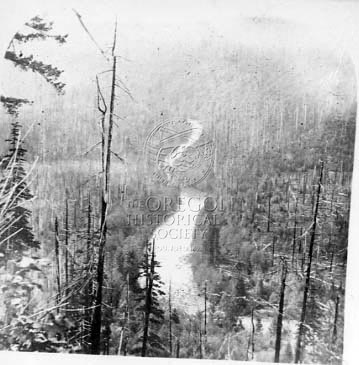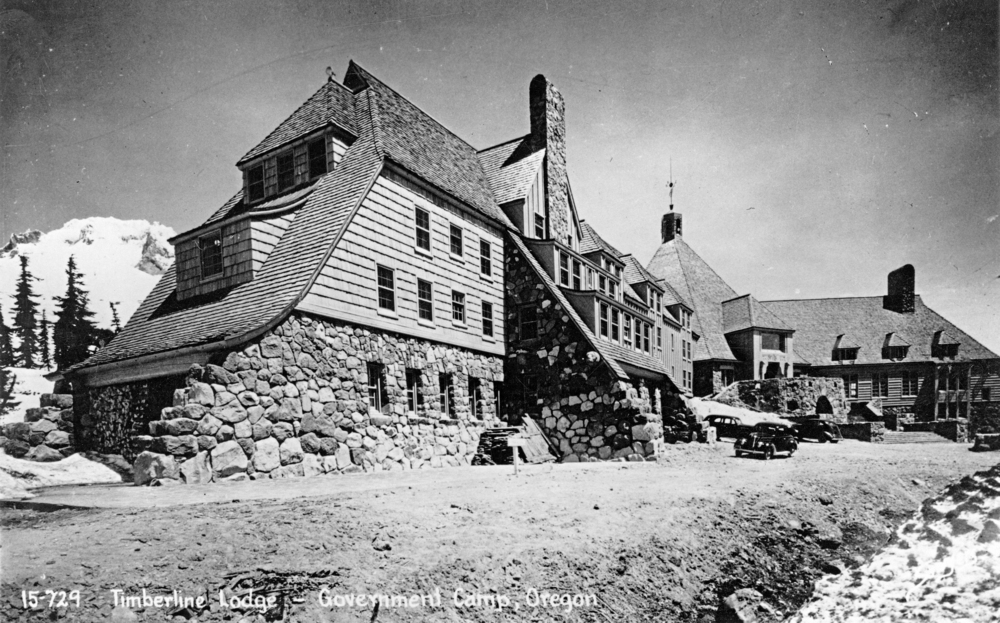On October 11, 1845, Joel Palmer wrote about a ravine on Mount Hood: “The manner of descending is to turn directly to the right, go zigzag for about one hundred yards, then turn short round, and go zigzag until you come under the place where you started from; then to the right, and so on, until you reach the bottom.”
Palmer, together with William Rector and Samuel K. Barlow, led two groups of overlanders around Mount Hood, from The Dalles to Oregon City. Palmer, searching for the best route, crossed from the White River to a canyon near timberline on the southwest side of Mount Hood and descended one ridge of a steep mountain slope. The party commemorated the back-and-forth pattern by applying the name Zigzag to the ravine, the canyon, and the mountain. One of the glaciers above the canyon was later called Zigzag Glacier.
The following year, Barlow established the Barlow Road, a toll road that overlanders followed in preference to floating on rafts down the Columbia River. The emigrants paid at toll gates, one of which is now the site of a Forest Service campground east of the town of Rhododendron. A post office opened in February 1917 to serve a community west of the Barlow Toll Gate. A year and a half later, in September 1918, the name of the post office was formally changed to Zigzag, and that name was applied to the community as well.
One of the best-known residents of Zigzag was William John Lenz, who was born in The Dalles in 1885. Lenz, who was raised in Hood River, was a hiker, guide, hunter, musician, and storyteller. He also built wood furniture and log buildings, including the first Mazama Lodge at Government Camp on Mount Hood. In 1927, using hand-cut logs, Lenz built the original Zigzag Inn near the intersection of Lolo Pass Road and Mount Hood Loop Road (now Highway 26). After he settled in Zigzag, he sometimes hiked across Lolo Pass to Hood River to visit his mother.
In May 1933, Camp Zigzag was constructed as Oregon’s first Civilian Conservation Corps (CCC) camp. Most of the men who lived at the camp, working in reforestation and building trails and camps in the national forests, were from Oregon. They constructed buildings at the U.S. Forest Service Zigzag Ranger Station across Highway 26 from the camp, worked on terracing for Timberline Lodge, and built the Timberline Trail. On September 28, 1937, when President Franklin Roosevelt dedicated Timberline Lodge, CCC men lined the road at Zigzag to greet him as he motored from the lodge to Portland.
The Zigzag post office closed in 1974. The community has remained unincorporated and is now recognized as a local landmark. Together with Alder Creek, Brightwood, Wemme, Welches, and Rhododendron, Zigzag is part of the Villages of Mount Hood.
-
![]()
Section of the Zigzag River known as the "Back Bone," 1871.
Oregon Historical Society Research Library, 015991
-
![]()
CCC workers at Zigzag camp, 1933.
Oregon Historical Society Research Library, 372A0763
-
![]()
Zigzag Canyon.
Oregon Historical Society Research Library, Stout109
-
![]()
CCC workers, Zigzag, 1935.
Oregon Historical Society Research Library, 372A0754
-
![]()
CCC buildings at Zigzag, 1933.
Oregon Historical Society Research Library, 371A5969
-
![]()
CCC tents at Toll Gate camp, Rhododendron, 1933.
Oregon Historical Society Research Library, Journal, 371A5972
-
![]()
Zigzag Ranger Station.
Courtesy U.S. Forest Service -
![]()
Joel Palmer, c.1860.
Courtesy Oregon Hist. Soc. Research Lib., Orhi362
-
![]()
Barlow-Foster toll gate at Rhododendron, Oregon, 1885.
Courtesy Oregon Explorer, Oregon State University. "Barlow-Foster toll gate at Rhododendron, Oregon" Oregon Digital.
Related Entries
-
![Barlow Road]()
Barlow Road
The Barlow Road is a historic wagon road that created a new route on th…
-
![Joel Palmer (1810–1881)]()
Joel Palmer (1810–1881)
Joel Palmer spent just over half of his life in Oregon. He first saw th…
-
![Timberline Lodge]()
Timberline Lodge
Timberline Lodge is the showplace for Works Progress Administration pro…
-
![Zigzag Ranger Station]()
Zigzag Ranger Station
Zigzag Ranger Station is the headquarters for the Zigzag District of th…
Map This on the Oregon History WayFinder
The Oregon History Wayfinder is an interactive map that identifies significant places, people, and events in Oregon history.
Further Reading
Grauer, Jack. Mount Hood: A Complete History, 3d ed. Vancouver, WA: Jack Grauer Publisher, 2005.
McArthur, Lewis A., and Lewis L. McArthur. Oregon Geographic Names, 7th ed. Portland: Oregon Historical Society Press, 2003.
McNeil, Fred H. Wy’East: A Chronicle of Mount Hood. Portland, OR: Metropolitan Press, 1937.












